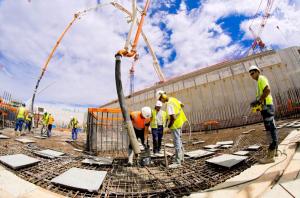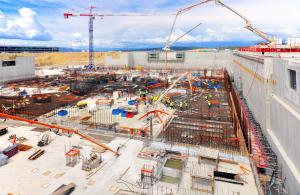A concrete for every purpose
Gravel, sand, cement, water and sometimes an additive ... at first glance, concrete seems like a simple material. But not at ITER, where construction follows strict norms and regulations, and every step is verified not once ... but many times

Two 1.5-metre-thick concrete basemats are already in place in the Tokamak Seismic Pit. For the lower basemat, which supports the 493 anti-seismic columns, a rather "standard" concrete was chosen that has a resistance to compression of approximately 3,000 tons per square metre.
For the upper level basemat—the "floor" that will support the machine and the Tokamak Complex buildings—superior resistance is called for (4,000 tons per square metre) as well as particular qualities related to nuclear confinement as it must act as the ultimate confinement barrier after the vacuum vessel walls and the 3.5-metre thick bioshield.
Strongest of all is the concrete for the crown-shaped pedestal of the 23,000-ton ITER Tokamak, which is required to have a degree of resistance two to three times that of the Tokamak Complex floor. (This particular formula is still undergoing qualification activities.)
And finally in the immediate proximity of the Tokamak (the bioshield, for example), contractors will employ "heavy concrete," where the typical granular materials are replaced by iron ore. For this concrete, the mass of one cubic metre increases from 2.4 to 3.6 tons.
Whether ordinary or exceptional, the concrete used in ITER construction is the object of control and verification at each stage of its elaboration and implementation. All concrete formulas are tested by the contractor in charge of concrete pouring, both in the laboratory and in real-scale mockups.
Consistency and spreadability are also important parameters in order to ensure the homogenous distribution of the concrete throughout tight matrixes of steel reinforcement. These parameters are tested as the concrete leaves the on-site batching plant and before it gets loaded into the mixer trucks.
For each realization on the worksite, samples are taken and stored in order to study the evolution of the concrete over the short and long term (2 to 90 days). "We rely on systematic verification and testing," say Damien Sorbier and Romain Paix, both engineers with the Engage consortium, in charge of detailed design and work supervision for the European Domestic Agency. "But everything is well prepared ahead of time so that we don't have any surprises..."
On pouring days, operators must also keep a close eye on ambient temperature. The concrete can't leave the batching plant if the thermometer displays a temperature of 10°C or lower; pouring is also cancelled if temperatures exceed 30°C. Mid-winter or mid-summer, the concrete is sometimes warmed or cooled to remain within acceptable parameters.
No effort is too great to ensure the quality of the concrete and its implementation because for ITER, this will determine the integrity and the safety of the entire installation.


